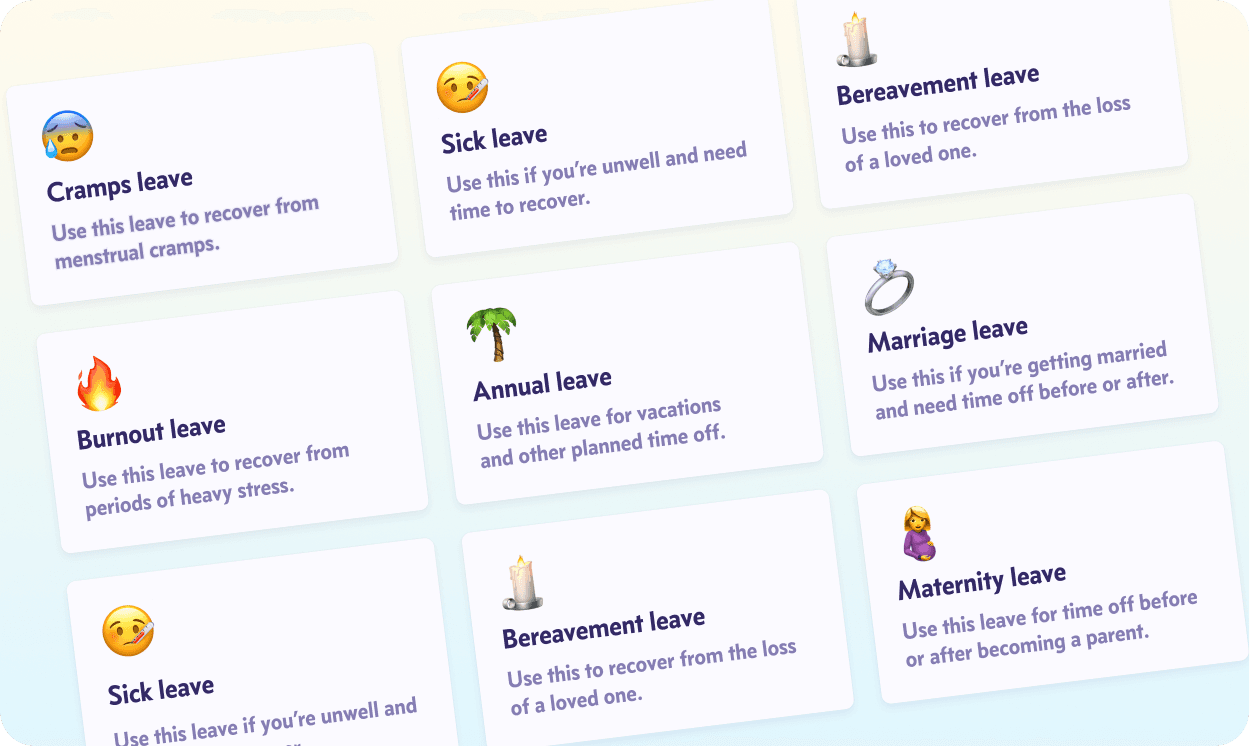Mastering the art of leave policy communication: A guide for HR managers and founders
May 4, 2023

Picture this: you're an HR manager at a bustling startup.You've just settled into your desk with a steaming cup of tea when your inbox starts to fill up with emails from employees. The issue? They’re asking about their remaining leave balances, how to apply for time off, and what the process is for emergency leaves. Sound familiar?
Navigating leave policies and ensuring employees understand them can be a time-consuming and tedious task for HR managers and founders alike. However, clear communication of these policies is essential to maintain a healthy work environment and avoid any misunderstandings.
In this blog post, we'll guide you through the process of effectively communicating leave policies to employees to save you time, reduce confusion, and keep your workplace running smoothly.
Understand the company's leave policies
Before you can effectively communicate your company's leave policies to employees, it's crucial that you have a solid understanding of them yourself. Make sure you're well-versed in the details of your organisation's policies, including:
Types of leaves (e.g., annual, sick, maternity, paternity, etc.)
Eligibility criteria
Duration of leaves
Approval process
Carry-over provisions
Moreover, it's essential to be aware of any legal requirements and compliance factors specific to your location and industry. This includes familiarising yourself with local and federal laws and any industry-specific regulations that may apply to your company.
Create a comprehensive leave policy guide
Once you have a thorough understanding of your company's leave policies, the next step is to create a comprehensive guide for your employees. Here are a few tips to help you design an effective and user-friendly document:
Clear language and formatting
Keep the language simple and concise. Use bullet points, headings, and subheadings to break down complex information and make it more digestible.
Visual aids and examples
Use charts, tables, and real-life examples to illustrate different scenarios, making it easier for employees to understand the policies.
Include all relevant information
The guide should cover all the necessary details, such as the types of leaves, application procedures, deadlines, guidelines for unplanned leaves, and contact information for questions or concerns.
Make the document easily accessible
Ensure that both digital and physical copies of the guide are available to employees. Post the document on your company's intranet, shared drives, and include it in your employee handbooks.
Communicate the policy to employees
Now that you have a comprehensive guide, it's time to share it with your employees. Start with an initial communication to introduce the policy, and then establish ongoing communication channels to keep employees informed. Here are some tips on how to do this:
Initial communication
Introduce the policy during onboarding sessions for new employees.
Send an email announcement to all employees with a link to the leave policy guide.
Schedule a company-wide meeting to present the policy and answer any questions.
Ongoing communication
Share regular reminders and updates via newsletters, emails, or team meetings.
Encourage managers to discuss leave policies with their teams and address any concerns.
Offer training sessions for updates or revisions to the policies.
Use leave management software for seamless communication
To streamline the communication and management of leave policies, consider implementing a leave management system like Pause. Here's how Pause can help your organization:
Centralised platform
Pause provides a single platform for managing leave requests, making it easier for both employees and managers to keep track of time off.
Real-time tracking
Employees can view their leave balances in real-time, reducing the need for HR managers to answer individual inquiries.
Automated notifications and reminders
Pause can send automated notifications to employees and managers about upcoming leave dates, application deadlines, and policy updates, This minimises the chances of miscommunication and also saves your inbox from being flooded with questions.
Evaluate and improve the communication process
To maintain an effective communication strategy for your leave policies, it's essential to evaluate and improve the process continually. Here's how you can do that:
Regularly review the policy and its communication
Assess the effectiveness of your current communication methods and identify any areas that need improvement.
Gather employee feedback
Encourage employees to share their thoughts and experiences with the leave policy communication process through surveys, focus groups, or anonymous suggestion boxes.
Adjust communication strategies as needed
Based on the feedback and your evaluations, make any necessary adjustments to your communication channels, policy guide, or software tools.
The final word
In conclusion, effectively communicating leave policies to employees is crucial to maintaining a healthy and efficient work environment.
By creating a comprehensive guide and establishing clear communication channels, you can save time, reduce confusion, and promote a better understanding of leave policies among your employees.
And if you’d like to automate all of this, you’re already in the right place. Pause can take the gruntwork off your hands and keep your employees informed so you can focus on what’s important: growth and innovation. If you’re ready, start your 30-day free trial here!


